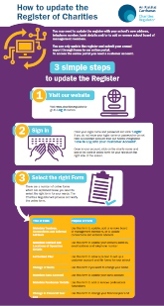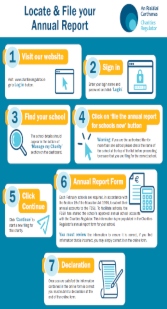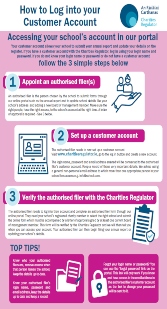General Public FAQs relating to emerging or existing crises
-
How can I show my support / make a donation to assist with an emerging or existing crisis?
Making donations is the easiest way to help. Anyone wishing to support people affected by a crisis should ensure that any donations they are making are going to registered charities that have a track record of providing the kinds of practical supports and assistance that the people impacted by the crisis, and those who are supporting them, need at the time. You can check whether a specific Irish charity is registered on the Register of Charities.
-
What charity should I donate to?
While we cannot recommend a particular charity there are existing registered charities operating in Ireland that have significant experience providing assistance to a wide range of national and international crises, such as supporting refugees, operating within conflict zones and providing essential aid and supports. Please check the Register of Charities before you donate.
-
I’d like to set up a charity to help. Can I set up a new charity / expedite the application process to assist with a crisis?
It is against the law in Ireland to set up a charity and to start collecting donations without being registered with the Charities Regulator. It’s easier and quicker to donate to established charities rather than set up your own. As anyone who has recently registered with the Charities Regulator will know, this registration process is, by necessity, a rigorous one. It is therefore essential that any member of the public who might wish to raise funds or provide other forms of assistance to people affected by a national or international crisis, links to an existing registered charity that has an established organisational framework in place and experience of providing aid and support in similar crisis situations. This will help ensure that donations go directly to those most in need.
-
Should I travel to assist with a crisis?
You can view The Department of Foreign Affairs travel advice in relation to travelling overseas. The Department offers an objective assessment of the risks you could face when travelling to different countries.
Registered Charities FAQs relating to national or international crises or disasters
-
How can my charity help with a newly emerging national or intentional crisis or disaster?
If you are a registered charity and wish to lend support to a newly emerging national or international crisis such as the war in Ukraine, or a natural disaster such as the earthquake in Turkey and Syria, there are a number of very important issues for your charity to consider:
1. Does the charitable purpose for which your charity was set up include providing crisis support/funding/donations to other registered charities or beneficiaries directly?
If your charitable purpose does not include providing crisis support/funding/donations and you wish to help with an emerging crisis you may need to add a new charitable purpose. If your charity is considering adding a new purpose you must do the following:
a) Follow your own internal rules to approve adding a new charitable purpose
and then
b) Seek consent from the Charities Regulator.
To seek consent from us you will need to log into your customer account in our online portal and submit a change of purpose form where it will be assessed by the Charities Regulator.
Please see our guidance for accessing your customer account and these forms here. https://www.charitiesregulator.ie/en/information-for-charities/myaccount
2. Does your governing document allow your charity to provide crisis support/ funding/donations?
For information the governing document is the legal document outlining what your organisation is and how it operates. It is usually called the ‘constitution’, but may also be known as the ‘rules’, depending on the charity’s legal structure. Your organisation's governing document should provide the basis for everything that your organisation will do and how it will do it.
If your governing document does not allow your charity to provide crisis support/funding/donations and you wish to help with an emerging crisis, making changes to the governing document may alter the nature of the organisation to such an extent that it no longer qualifies as a charity under the Charities Act 2009. This is why charities looking to amend their governing document are required to seek approval from the Charities Regulator prior to adopting any changes. To do this you will need to log into your customer account in our online portal and submit a change of purpose form where it will be assessed by the Charities Regulator.
3. Do you intend using funds, donations or grant monies already given to the charity for another purpose to lend support to a new crisis?
You should be aware that when the donor gave you the funds, the donation was based on your charitable purpose at that time. Those donations cannot be used for any purpose other than the original purpose for which they were given.
-
Do you have appropriate cyber security in place?
In certain instances there is the need for heightened vigilance in relation to cyber security and increased risk of cyber-attacks and phishing. Further information on this is available from the Garda National Cyber Crime Bureau.
https://www.garda.ie/en/about-us/organised-serious-crime/garda-national-cyber-crime-bureau-gnccb-/
-
Have you considered getting legal advice to determine what your charity can and cannot do?
It may be prudent to seek legal or professional advice to determine whether your charity can undertake new activity, or whether changes are required to its governing document.
Accessing MyAccount – Technical Questions
The infographics below are designed to help you navigate our customer portal. Please click on each to enlarge. Take a look before accessing 'My Account'
Charities
Schools
-
How do I access my charity’s customer account – MyAccount?
You need your login name and password to access the charity account.
Sign into your charity’s customer account on the MyAccount Login page.
-
How do I create a customer account – MyAccount?
You will need to create a new user account by clicking on Create Account.
An email will then be sent to the email address you have provided. This email contains a verification link.
-
I cannot remember my Login Name and/or my Password, can you help?
You need your login name, password and access to the email address linked to your customer account to access the customer account.
Your Login Name was created when the customer account was set up. Your Login Name can be an email address or simply a name.
If you cannot remember your Password, click the ‘Forgot Password’ link on the MyAccount Login page.
Then enter the Login Name for your customer account.
We will send you an email with instructions to change your password.
This link will only work if you have provided a valid Login Name and have access to the email address linked to your customer account.
Important: If you do not receive an email from us, you may not have provided the correct Login Name linked to your customer account.
If you cannot remember your Login Name, click the ‘Forgot Password’ link on the MyAccount Login page.
Then click ‘Forgot Login Name’ and enter the email address linked to your customer account.
This link will only work if you know and have access to the email address linked to your customer account. We will send you an email with the list of Login Names registered on this email address.
Important: If you do not receive an email from us, you may not have provided the correct email address linked to your customer account.
If you cannot remember your login details and/or you cannot access the email address linked to your customer account, you will need to create a new user account by clicking on Create Account link.
An email will then be sent to the email address you have provided. This email contains a verification link.
When you have verified your new customer account, you should file an Authorised Filer form to access your charity’s account.
Once logged in to your new customer account, click on Start New Filing.
There will be a pop-out from the right hand side, click on Existing Charity at the top.
Then enter your Registered Charity Number in the Search for a Charity bar.
You can then file an Authorised Filer form on behalf of the charity.
You must upload a letter of authorisation on the charity’s headed paper, signed by at least one current charity trustee, registered with the Charities Regulator. Please note, we do not accept digital signatures e.g. typed signatures.
You can review the information on the Register of Charities, including registered charity trustees, by clicking here and searching for the charity.
Suggested wording for the letter of authorisation is available on page 3 of the user guide here.
Note: Submitting the authorised filer form does not give you immediate access to the charity’s account. This form will be verified by the Charities Regulator and we will tell you when you can access your account. The processing of this form may take 1-2 working days. We will send you an email to let you know when we have granted you access to the charity’s account. The authorised filer can then begin filing your annual report or updating your charity’s details.
The next time you login to MyAccount, you will see the charity listed under 'Manage My Charity' on your dashboard. -
I have logged into MyAccount but cannot access any forms to manage my charity including the Annual Report. What am I doing wrong?
a) If you have never accessed your customer account in our new IT system:
You will need to update your contact information in My Profile before you can submit forms for the first time.
 Click on this symbol at the top right of the screen, and click on My Profile.
Click on this symbol at the top right of the screen, and click on My Profile.Click the Edit button and fill in the First Name, Last Name, and Phone Number.
Click on Save and then return to the Dashboard.
You will now be able to access any forms to manage your charity including the Annual Report form.
or
b) Your MyAccount is not linked to your charity:
You will need to file an Authorised Filer form to access and file submissions on behalf of the charity.
Once logged in, click on Start New Filing.
There will be a pop-out from the right hand side, click on Existing Charity at the top.
Then enter the Registered Charity Number you wish to file for in the Search for a Charity bar.
You can then file an Authorised Filer form on behalf of the charity.
A letter of approval signed by at least one Charity Trustee currently listed on the Register of Charities must be uploaded with this form – see page 3 of the user guide here.
-
I am working on behalf of a charity but do not have access to MyAccount. How can I file an Annual Report or other forms for this charity?
You will need to create a user account by clicking on Create Account if you do not already have a customer account (MyAccount).
Once logged in, click on Start New Filing.
There will be a pop-out from the right hand side, click on Existing Charity at the top.
Then enter the Registered Charity Number you wish to file for in the Search for a Charity bar.
You can then file an Authorised Filer form on behalf of the charity.
A letter of approval signed by at least one Charity Trustee currently listed on the Register of Charities must be uploaded with this form – see page 3 of the user guide here.
-
How secure is the Charities Regulator website?
The Charities Regulator's website operates to the highest available security standards. To verify that the page is secure, please check that there is a padlock icon in your browser.
-
How do I access my charity’s customer account – MyAccount?
You need your login name and password to access the charity account.
Sign into your charity’s customer account on the MyAccount Login page
Charities Governance Code
-
What is the Charities Governance Code?
The Charities Governance Code (PDF file) is made up of -
- six principles of governance, which all charities should apply,
- core standards that we expect all charities to meet when putting the principles into action, and
- additional standards that reflect best practice for charities with high levels of income and/or complex organisational and funding structures and/or a significant number of employees.
We wrote the Code with volunteer-only charities and charities with a small number of paid staff in mind, as this reflects the reality of the charity sector in Ireland where these two groups make up the majority of registered charities.
Additional governance standards have been included, which we expect more complex charities to meet.
For these reasons, the Code is relevant for every charity operating in Ireland.
-
Who is the Code for?
The Code is for charity trustees. The term ‘charity trustee’ includes:
- committee members;
- council members;
- board members;
- company directors.
By law, charity trustees have individual and joint responsibility for what happens within their charity. This means that if their charity does not meet its legal duties, they are responsible both as individuals and together as a board, committee, council or other core group (referred to in this Code as the ‘board’).
-
What are the six principles of the Code?
Charity trustees are responsible for the governance of their charity and should make sure that the following governance principles are being applied.
The charity is:
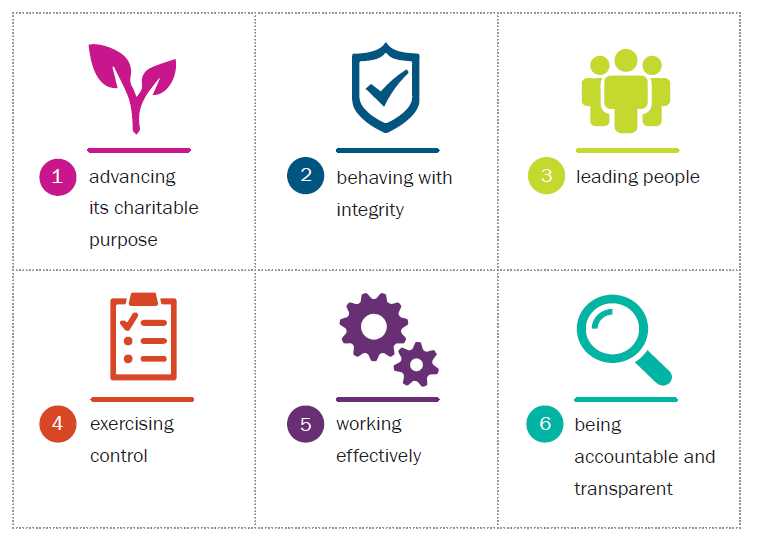
-
What are the ten steps to comply?
Step 1
Read the Charities Governance Code (PDF file) (the 'Code') in full.
Step 2
Decide if your charity is more complex for the purpose of the Code.
Step 3
For each standard, decide what action or actions you will take to meet that standard in your charity.
Step 4
State each action next to the relevant standard in the Compliance Record Form (WORD doc).
Step 5
If any of the standards do not apply to your charity, explain why next to that standard in the Compliance Record Form (WORD doc).
Step 6
Decide what evidence you can provide for the action or actions that you are taking to meet each standard that applies to your charity.
Step 7
State the evidence you can provide next to the relevant action in the Compliance Record Form (WORD doc).
Step 8
Review the Compliance Record Form (WORD doc) and agree it is accurate at a board meeting.
Step 9
Declare your charity’s compliance (or provide your charity’s reason for not complying) with the Code when submitting your annual report to the Charities Regulator.
Step 10
Having considered the standards, actions and evidence (Steps 3 to 7) again, complete a fresh Compliance Record Form (WORD doc) at a board meeting every year before reporting on compliance to the Charities Regulator.
-
Is it mandatory for registered charities to comply with the Charities Governance Code?
The Code operates on a ‘comply or explain’ basis, meaning that charities must comply with the Code or else explain why they have not done so.
Non-compliance with the Code or a particular standard within the Code may be justified in particular circumstances. Explanations should clearly set out your reasons for non-compliance.
-
What are the benefits of compliance with the Charities Governance Code?
The six principles are linked to the legal duties of charity trustees. The Code specifically aims to help charity trustees to put good governance systems and processes in place which will assist them in meeting their legal duties under charity law.
Compliance with the Code should give confidence to your funders and donors and improve a charity’s ability to raise funding and to attract new board members and volunteers.
Good governance minimises the risk of fraud and other damaging practices and ensures your charity is managed in a way that serves the best interests of the charity and its beneficiaries.
-
Where do I start?
The Charity Governance Code outlines ten steps to compliance. These can be found on page 11 of the Charities Governance Code.
As a starting point you should do the following:
- Read the Charities Governance Code in full and discuss it at your next charity trustee meeting.
- Develop a plan that allows you to address all six principles within the Code throughout the year.
-
Are we a complex charity or a non-complex charity for the purpose of the Charities Governance Code?
Due to the significant variation that exists in terms of the size and type of charities that make up the charities sector, the kind of work that they undertake, where they operate, their legal structure and how they carry out their charitable purpose, it is not possible to definitively state what a complex charity is. The Charities Regulator does not determine what type of charity you are. Ultimately, the charity trustees of each organisation are best placed to make an informed decision regarding what is right for their charity and whether it is a complex charity. Please see our guidance document which sets out a number of factors and indicators that charity trustees should consider and on which they may base this decision on. Charities Governance Code Complex and Non complex Charities
-
We were fully compliant with the Governance Code for Community, Voluntary and Charitable Organisations, do we need to start all over again?
No. If your charity is currently well governed, the Charities Governance Code may not require you to make any significant changes. However you should consider how you might develop any existing governance standards, your charity already has in place to accommodate the requirements of the Charities Governance Code.
You must complete the Compliance Record Form and declare your compliance with the Code when submitting your annual report to the Charities Regulator.
-
We are a compliant organisation – what do we need to do now?
You must complete Compliance Record Form indicating the actions that your charity takes to meet each standard in the Charities Governance Code and the evidence that backs is up. You should approve the Compliance Record Form at a board meeting before you report on your compliance to us.
You will be required to declare compliance when submitting your Annual Report. A detailed user guide on how to complete the Charities Governance Code section of the annual Report is available here.
-
We have completed our compliance record form – do we need to submit it to the Charities Regulator?
No, you are not required to submit the compliance record form to the Charities Regulator. You must keep this form as the Charities Regulator could ask you for it at any time. To comply with the Code, you must complete the Compliance Record Form every year.
-
Our board meetings are dominated by one or two charity trustees who are refusing to implement or accept the necessary changes? What can we do?
It is not uncommon for a board to find itself being led by one domineering trustee. An external governance specialist can help by offering independent advice based on professional experience.
Some other preventative measures to consider are as follows:
- Setting terms limits;
- Conducting annual board reviews and individual assessments;
- Adopting a code of conduct for charity trustees;
- Ensuring an effective induction process;
- Establishing clear role descriptions.
-
We are a small charity and regularly meet to discuss day-to-day issues. How many Board meetings should we have a year?
How many meetings is entirely a matter for each charity to decide. As a board you should be meeting as regularly as you need to in order to ensure that:
- all charity trustees involved in the board are able to properly oversee the charity’s activities;
- those managing and working in the charity receive any required approval in a timely manner (by way of decisions made and recorded at Board meetings) to carry out the day-to-day work of the charity.
The number of board meetings that is required will therefore depend on the size, income and structure of the charity.
-
We are a small charity so the charity trustees discuss all relevant issues at weekly meetings, which would not necessarily be formal board meetings. Will this suffice for the purposes of the Code?
All decisions of the board of charity trustees should be documented so that there is evidence of what decisions are made and when those decisions are made. The fact that matters are discussed by other committees or groups in the charity will not suffice if it cannot be demonstrated, by reference to documented minutes, that the board of charity trustees discussed and agreed a course of action on a particular matter.
-
Standard 1.8 requires charities to consider the advantages and disadvantages of working in partnership with other charities. What does ‘working in partnership’ mean?
Working in partnership can cover a wide range of formal and informal arrangements. A simple informal arrangement may include networking, joint events, shared advertising or campaigning, sharing resources or just sharing ideas and working together for common goals. As the level of collaboration increases, a more formal legal agreement may become necessary. In some cases a decision to work together can lead to a more formal arrangement such as the merger of two or more charities (see our Guidance on Winding Up a Charity). Depending on the nature of any arrangement, professional advice may be required. Care needs to be exercised when sharing information with any other charity that any issues around confidentiality or GDPR are adequately addressed.
When contemplating working in partnership with other charities, you should start by asking what do you intend to achieve. You must properly consider and be satisfied that working in partnership with another organisation:
· will further your charitable purpose;
· will be an appropriate and effective way of using your charity’s resources;
· will be in your charity’s best interests;
· is not prohibited by your charity’s governing document; and
· that you have identified and can deal with any possible risks involved. -
Does the Regulator provide certificates which confirm that a charity is in compliance with the Charities Governance Code?
The Charities Regulator does not issue a certificate of compliance with the Charities Governance Code. Any charity which declares on its Annual Report that it is in compliance with the Code will have that declaration publicly displayed on the Register of Charities from the date that the Annual Report is filed. Charities may publicise their compliance with the Code on their website or other social media platforms if they so wish. However, charities should be careful to ensure that such public declarations are kept up-to-date. Where a charity makes a declaration to the Charities Regulator that it is in full compliance but is unable to provide evidence to the Charities Regulator of its compliance when contacted, it will be required to update its declaration. Any statements regarding the charity’s compliance with the Charities Governance Code that appear on the charity’s website or other social media platforms should also be immediately updated to reflect the amended declaration appearing on the Register of Charities.
Charitable Bequests
You will find guidance on Charitable Bequest Forms and how to submit receipts on the Charity Service Unit’s webpage.
Charitable Trusts
You will find guidance on Charitable Bequest Forms and how to submit receipts on the Charity Service Unit’s webpage.
Schools
The infographics below are designed to help you navigate our customer portal. Please click on each to enlarge. Take a look before accessing 'My Account'
Schools
-
Why does my school need to register as a Charity?
Primary, special and post-primary schools which hold a valid roll number assigned by the Department of Education and Skills are legally required to submit an application for inclusion on the Register of Charities. These schools come within the terms of the Charities Act 2009, falling within the definition of an ‘education body’.
-
How do I Register my School as a Charity?
To submit an application for charitable status, you will need to create a user account, known as ‘MyAccount’, log in, complete and submit your application.
Click on Create Account on the MyAccount Sign In page if you do not have a customer account.
You must be logged into MyAccount to submit your school’s Registration Application.
-
Which Application should I submit?
The registration application system has been designed to assist the Charities Regulator to make decisions on applications more efficiently and includes specific forms for Primary/Special schools and Post Primary Schools.
Your application will be assessed for charitable status and a case officer will be in touch if they require any further information from you.
You will receive an official notification from the Charities Regulator once a decision on your application for charitable status has been made.
Please note that we cannot guarantee a timeframe for processing applications but wait times can be longer or shorter depending on the nature of the application and the responsiveness of the applicant to any queries raised by the case officer.
-
Are schools required to submit an annual report to the Charities Regulator?
All charitable organisations are obliged to report on their financial activities for the previous year in accordance with section 52 of the Charities Act 2009 by submitting an Annual Report form through the online portal to the Charities Regulator.
Each February schools are required, in accordance with the Section 18 of the Education Act 1998, to submit annual accounts to the FSSU. In order to facilitate schools, the FSSU has, since 2020, shared the schools’ approved annual accounts with the Charities Regulator. This information is then pre-populated in the Charities Regulator’s annual report form for your school. In order to complete the process, each school must declare that the information is correct and submit the annual report via the online portal on our website.
If you find information that is incorrect in the pre-populated form, simply correct it on the pre-populated form. Please inform the FSSU of any corrections you make.
The steps above are outlined in our helpful infographic here.
To access your customer account or if you cannot remember your login name or password, you will find instructions in our helpful infographic here.Annual Reports outstanding prior to 2019
Annual report forms are pre-populated for the years 2019, 2020 and 2021. However, annual report forms outstanding prior to 2019 are not pre-populated. If you have not already done so, please input the information required and submit any outstanding annual report forms starting with the oldest. -
How to do I file an Annual Report for my school?
-
How do I access my school’s customer account – MyAccount?
Sign into your school’s customer account on the MyAccount Login page.
-
How do I reset my password?
You can reset your customer account’s password by clicking on the Forgot Password link on the MyAccount Login page.
Please note, you will need to update your contact information in My Profile if you have never accessed your customer account in our new IT system.
-
I no longer have access to my email address. How do I access my School’s charity account?
You will need to create a new user account by clicking on Create Account.
Once logged in, click on Start New Filing.
There will be a pop-out from the right hand side, click on Existing Charity at the top.
Then enter your Registered Charity Number in the Search for a Charity bar.
You can then file an Authorised Filer form on behalf of the school.
A letter of approval signed by at least one member of the Board of Management must be uploaded with this form – see page 3 of the user guide here.
-
I have logged into MyAccount but cannot access any forms. What am I doing wrong?
You must update your profile before you can submit forms for the first time.
 Click on this symbol at the top right of the screen, and click on My Profile.
Click on this symbol at the top right of the screen, and click on My Profile.Click the Edit button and fill in the First Name, Last Name, and Phone Number.
Click on Save and then return to the Dashboard.
-
How do I submit forms such as an Annual Report for my School?
You must be logged into MyAccount to file reports and forms on behalf of your school.
Once logged in, scroll to the bottom of the page and click on New Filing beside your charity.
There will be a pop-out from the right hand side, click on Existing Charity at the top and then click on Start for your charity.
-
How do I update my school’s Board of Management?
You must be logged into MyAccount to update your Board of Management. You should file a Maintain Trustees, Connections and External Advisors form.
Use this form to update, add or remove members of your Board of Management (charity trustees), or to update information relating to connections and external advisors.
Please note, a full residential address (including Eircode) is required for each trustee. You can enter the address or Eircode in the Search Address bar and then click the result to autofill the address.
-
How do I update the school’s email address?
You must be logged into MyAccount to update your school’s contact email address. You should file a Maintain Contact and Locations of Operation Details form.
How do I access my charity’s customer account – MyAccount?
Sign into your charity’s customer account on the MyAccount Login page.
Managing a Charity’s details using MyAccount
The infographics below are designed to help you navigate our customer portal. Please click on each to enlarge. Take a look before accessing 'My Account'
Charities
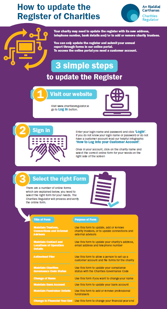
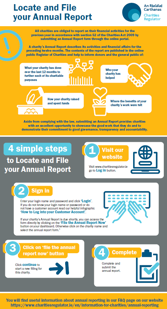
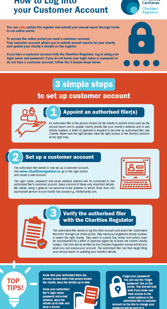
-
How do I update my charity’s details?
You must be logged into MyAccount to make any changes to the charity’s details in the Register of Charities.
You should refer to the Technical User Guide while using MyAccount to help you navigate your way through the new system. You may consider printing it out as a handy reference guide.
Sign into your charity’s customer account on the MyAccount Login page.
Scroll to the bottom of the page and click on New Filing beside your charity listed in the ‘My Charities’ section.
There will be a pop-out from the right hand side, click on Existing Charity at the top and then click on Start for your charity.
Locate the required form and click on Start and Continue.
-
What does the eye symbol mean?

Next to some of the information you submit there will be an "eye" symbol.
For organisations that are already registered, it indicates that this information will automatically appear on the Register of Charities.
If you are in the process of applying for registration, this will only appear on the Register of Charities if your registration is approved.
-
What does the ‘i’ icon mean?
 This icon means that there is a tip or short explanation available. You can move your mouse over any help symbols for further information.
This icon means that there is a tip or short explanation available. You can move your mouse over any help symbols for further information. -
I filed a form and it was returned to me for further information. How do I access the form?
You must be logged into MyAccount to edit your form.
Once you are logged in, click on My Filings in the menu at the left of the MyAccount home page to open a list of all filings (or forms) relating to your organisation under various heading tabs.
Any form you submitted (a ‘submission’) which has been returned to you seeking more information will be available under the Returned tab.
Alternatively, you can click on the returned heading under Submission Filings on the dashboard to open your submission.
-
How do I update my Charity Trustees?
You must be logged into MyAccount to update your Charity Trustees.
You should file a Maintain Trustees, Connections and External Advisors form.
Use this form to update, add or remove charity trustees, or to update information relating to connections and external advisors.
This form will appear blank. It is recommended that you start with the ‘Delete Trustee’ section of the form. You can use the same form to make all changes to your board of charity trustees.
Please note, a full residential address (including Eircode) is required for each trustee. You can enter the address or Eircode in the Search Address bar and then click the result to autofill the address.
-
A charity trustee has a conflict of interest. How do I notify the Charities Regulator?
You are requested to outline any connections (including family, business and employment relationships) which exist between your trustees or the founder of your organisation and any of your employees or suppliers of goods or services.
You must be logged into MyAccount to declare this connection to your charity.
You should file a Maintain Trustees, Connections and External Advisors form.
-
How do I update the charity’s email address?
You must be logged into MyAccount to update your charity’s contact email address.
You should file a Maintain Contact and Locations of Operation Details form.
-
How do I submit an Annual Report for my charity?
You must be logged into MyAccount to file reports and forms on behalf of your charity.
Sign into your charity’s customer account on the MyAccount Login page.
Once logged in, scroll to the bottom of the page and click on New Filing beside your charity.
There will be a pop-out from the right hand side, click on Existing Charity at the top and then click on Start for your charity.
Click here to be directed to the dedicated Annual Reporting page.
-
My charity has changed its next Financial Year End date, how do I update my charity’s account?’
You must be logged into MyAccount to update your charity’s Financial Year End date.
You should file a Change in Financial Year End form.
When you change your financial year-end it may affect your next annual report to the Charities Regulator as there must be continuous annual reporting i.e. there can be no gaps.
Please note, you should open a new Annual Report form once you are notified that the charity’s Financial Year End has been changed. Do not submit any existing draft Annual Report forms as these will undo any change to your Financial Year End.
-
How do I update the charity’s governing document or charitable purpose(s)?
You must be logged into MyAccount to apply for permission to update your charity’s governing document.
You should file a Change of Purpose form if you are proposing to change your charitable purpose(s), main object or make other constitution (governing document) amendments.
Please note: You should not adopt the changes until you have received approval from the Charities Regulator to do so.
IMPORTANT: There are standard clauses that must be included in all constitutions. We have a constitution template which we encourage charities to use.
The standard clauses and model constitutions are available on the ‘Guidance for Charities’ page.
-
How do I change the name of the charity?
You must be logged into MyAccount to apply for permission to change the name of your charity.
You should file a Change of Name form.
Please note: You should not adopt the amendments until you have received approval from the Charities Regulator to do so.
-
How do I update details of the charity’s Bank Accounts?
You must be logged into MyAccount to update, add or delete your charity’s bank accounts.
You should file a Maintain Bank Account form.
-
The charity uses professional fundraisers. How do I update their details?
You must be logged into MyAccount to update fundraising information such as adding or removing professional fundraisers.
You should file a Maintain Fundraiser Details form.
-
Where can I find more information about the Charities Governance Code?
The Charities Regulator website has a page dedicated to the Charities Governance Code.
You will also find the Charities Governance Code Toolkit there; this is a set of guidance notes and templates produced to assist and provide practical support to charity trustees.
Click here to be directed to the Charities Governance Code page.
-
What format and size restrictions are there for uploading documents?
The details are as follows:
- Format: Documents need to be in PDF (Portable Document Format) to be uploaded.
- Size: The maximum size of a file to be uploaded is 5mb.
-
How do I contact the Charities Regulator?
Should you require any further assistance you can send a help request through MyAccount messaging.
You must be logged into MyAccount to send correspondence through our internal messaging service.
Once you are logged in, click on Messages in the menu at the left of the MyAccount home page.
Click on New Message to send a help request or click on Reply to respond to a message from the Charities Regulator.
Charity Services Unit - Charities Acts 1961 and 1973 Applications
-
I want to make an application under the Charities Acts 1961 and 1973. How do I file an application?
You will need to create a user account by clicking on Create Account if you do not already have a customer account (MyAccount).
Once logged in, scroll to the bottom of the page and click on the Charity Services icon on the dashboard.
Locate the required form and click on Start.
Click here to be directed to the dedicated page for applications under Charities Acts 1961 and 1973.
-
What are the meeting dates of the Board of the Charities Regulator and the Charity Services Committee (CSC)?
The scheduled dates of meetings of the Board of the Charities Regulator (the Board) and the Charity Services Committee (CSC) in 2025 are as follows. Please read the section on the Charity Services Unit webpage entitled “Application Review Process” and other relevant guidance above before submitting an application to the Charity Services Unit of the Charities Regulator. Please note these dates are provisional and are subject to change without notice.
Charity Services Committee (CSC) and the Board of the Charities Regulatory Authority Dates 2025
Closing or Winding Up a Charity
-
What do I do if my charity is no longer active, is winding up or has closed?
-
What do I do if my charity is no longer active, is winding up or has closed?
The process will depend on your organisation:
If your charity received a CHY number from the Revenue Commissioners after 16 October 2014:
In the first instance you should complete a voluntary de-registration form which can be accessed via our portal here. This form can only be filed by an Authorised Filer for the Registered Charity.
The Charities Regulator will then inform you of the next steps that need to be taken in order to wind-up the organisation in compliance with the law.
If your charity held a CHY number from the Revenue Commissioners before 16 October 2014:
In the first instance you should inform the Charities Section of the Revenue Commissioners through Revenue Online System (ROS) at:
or by phone at: 01-7383688
We would also ask you to complete a voluntary de-registration form which can be accessed via our portal here. This form can only be filed by an Authorised Filer for the Registered Charity.
Once all Revenue requirements have been satisfied by the charity, Revenue will cancel the CHY number and will notify us directly to remove the charity from the Register of Charities.
Click here to see our Guidance on Winding Up a Charity document.
-





